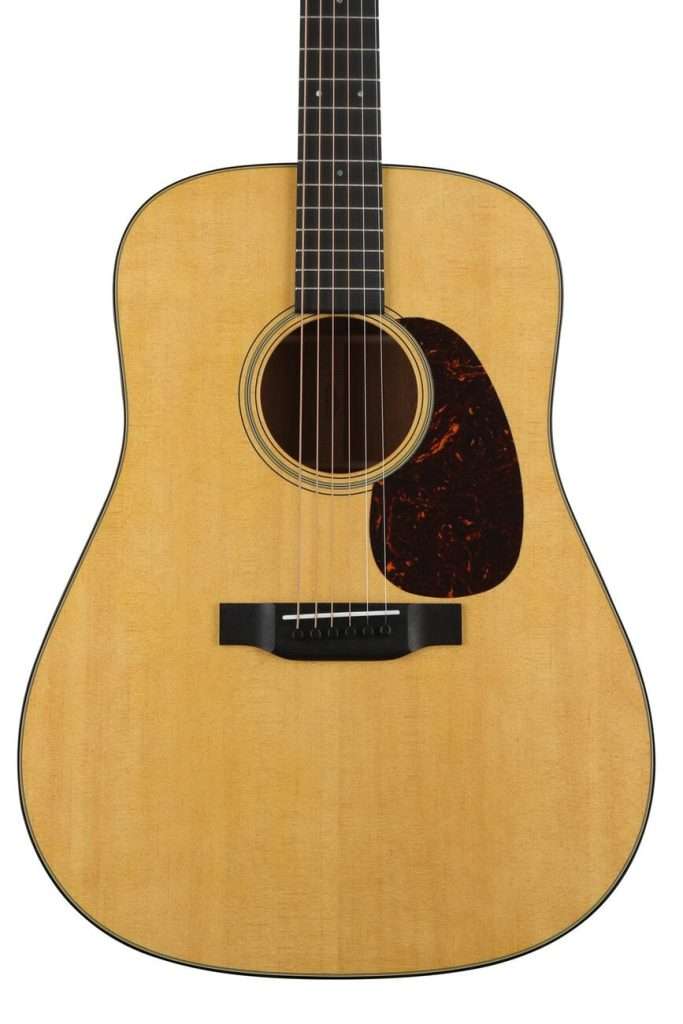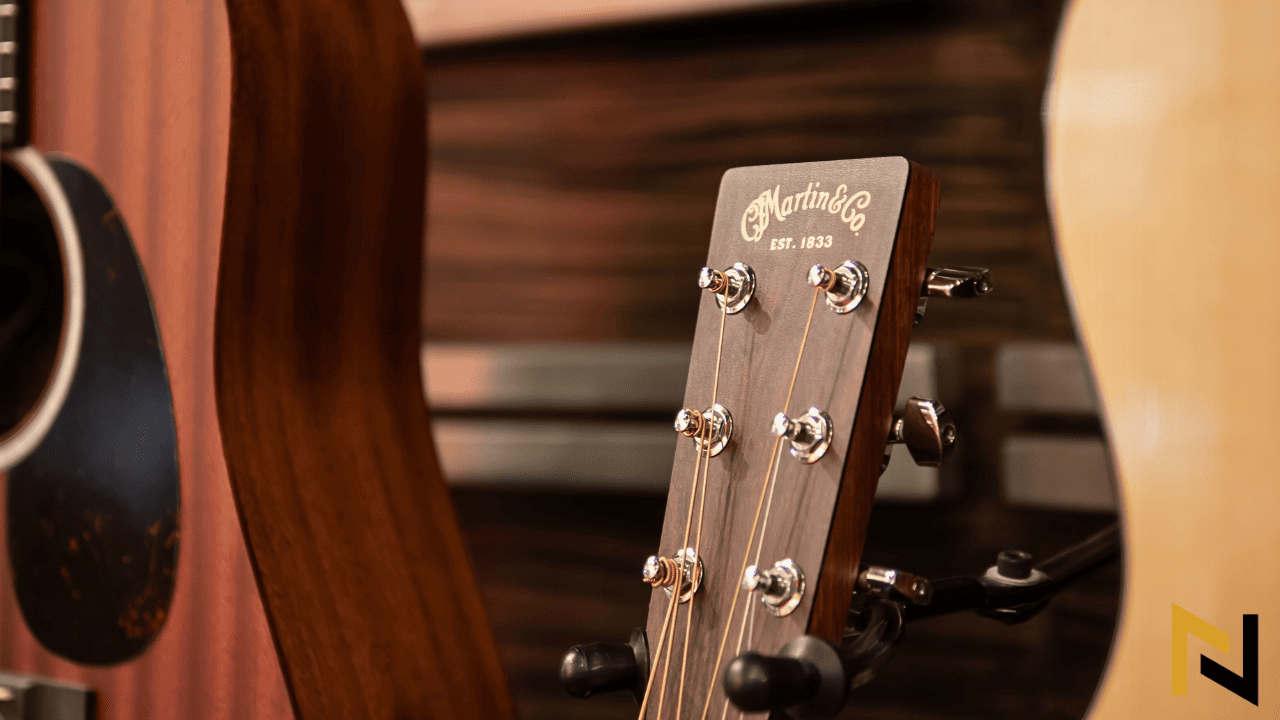It is well-known that Martin makes some of the best acoustic guitars in the world. If you’re looking into a Martin guitar, you have probably heard about the legendary Martin D-18 and D-28 models.
These guitars may look similar on the outside, but they have several distinct differences in their construction and sound. I have played a lot of Martin guitars in my life, and both of these guitars stand as some of the best I have ever played.
To understand how they compare, we have to take a closer look at both of them.
We have done all of the homework for you, so read on!
Martin D18 vs. D28 Acoustic Guitar: A Head-to-Head Comparison
Summary (if you’re in a hurry!)
Both the D-18 and the D-28 were created in 1931 and both are still built in the USA from premium tonewoods. The D-18 was the most affordable high-quality dreadnought acoustic guitar on the market at the time and both guitars became hits with guitar players in just a short time.
Both guitars are made from similar woods. The Martin D-18 is constructed of a hardwood neck with a solid Sitka spruce top and mahogany back and sides. The D-28 has a hardwood neck, a Sitka spruce top, and East Indian rosewood back and sides.
Here are other ways they compare and contrast:
| D-18 | D-28 | |
|---|---|---|
| Sound | Bright, crisp tone | Darker and warmer |
| Appearance | Lighter shade | Darker shade |
| Bracing | Scalloped bracing | Forward-shifted bracing |
| Cost | More expensive than the D-18 |
Bluegrass musicians love both models. This is because they require a guitar that produces a loud, full sound without sounding muddy and Martin guitars are known for producing clear sounds at loud volumes. This allows them to cut through a mix of other instruments without an amplifier.
You want a Martin D-18 if you like a brighter tone with more high-mids and crisp bass. Choose a D-28 if you want a rich, mid-forward tone with a warmer bass response. Both are great for rhythm playing and soloing.
Now, let’s take a closer look at the specs, design, construction, and sound of these two legends, as well as pricing information.
Key Specs for Martin D-18 and D-28
| Specifications | Martin D-18 | Martin D-28 |
|---|---|---|
| Body Shape | Dreadnought | Dreadnought |
| Back & Sides | Mahogany | East Indian Rosewood |
| Top | Sitka Spruce | Sitka Spruce |
| Neck | Hardwood | Hardwood |
| Finish | Gloss | Gloss |
| Bracing | X Scalloped | Forward Shifted X |
| Binding | Tortoise-colored | Antique white |
| Neck Radius | 16” | 16” |
| Fingerboard | Ebony | Ebony |
| Inlays | Old Style 18 | Mother-of-Pearl dots |
| Number of frets | 20 | 20 |
| Scale Length | 25.4” | 25.4” |
| Nut Width | 1.75” | 1.75” |
| Nut/Saddle | Bone/Bone | Bone/Bone |
| Tuning Machines | Nickel open gear | Nickel open gear |
| Body Length | 20” | 20” |
| Body Width | 15.6” | 15.6” |
| Body Depth | 4.8” | 4.8” |
| Overall Length | 40.5” | 40.5” |
Design & Materials
Shape & Size
Both the D-18 and the D-28 are dreadnought guitars. They are large-bodied guitars with a body length of 20”, a body width of 15.6”, and a body depth of 4.8”. They have a 25.4” scale length, and the overall length is 40.5”.
Materials & Construction
The Martin D-18 is constructed with:
- Solid mahogany back and sides.
- Solid Sitka spruce top.
- Ebony fingerboard.
- Select hardwood neck.

I inquired about the “select hardwood” neck, and a Martin representative told me it could be mahogany, utile, or another suitable hardwood, depending on what they had in stock at the time of manufacturing.
The D-28 is built from the following:
- Solid East Indian rosewood back and sides.
- Solid Sitka spruce top.
- Ebony fingerboard.
- Select hardwood neck.

Hardware
The nut and saddle of both models are made from bone. This allows for an excellent transfer of vibration from the strings and adds volume. The nickel open-gear tuners and the nickel frets are the same on both models.
Playability & Neck Profile
If both guitars are set up identically, they will feel and play nearly the same. The fingerboard width and neck profile are the same on both models, as are the other dimensions that would affect playability.
They are both made of solid wood, so they will both respond to humidity the same way, too. This typically causes the guitars to drift out of tune as the wood swells slightly in humid conditions. However, mahogany is stiffer than rosewood, so it may be more stable, but the difference is hardly noticeable.
Sound Comparison
My good friend, Steve Kilby, is an award-winning bluegrass player and long-time collector of Martin guitars. When it comes to sound, he told me:
“D-28s are usually more bassy and louder. D-18s are clearer and brighter, but there are exceptions in either style of Martin. Usually, I play old D-28s for their tone but I have a couple of good old D-18s. I usually play the D-28 in a bluegrass band situation whether onstage or in the studio. D-18s sound better with old-time bands or flatpicking.”
This difference in sound comes from the wood used for the back and sides. The sound of a D-18 is more focused and brighter because of the mahogany, while the rosewood on the D-28 makes it more bassy.
This difference in sound can also be attributed to their different bracing. The D-18 has scalloped X bracing and is more responsive overall. The D-28 has forward-shifted X bracing, which makes it louder and more bass-heavy.
If you need a loud guitar to stand out in the mix of other instruments (like a bluegrass band), then a D-28 may be what you need simply because of the volume. If you’re playing old-time fiddle tunes, flatpicking leads, or playing the blues, you may want to go with a D-18. They are certainly not limited to these styles, however. Each can hold its own with acoustic rock, pop, and country.
Pricing
The prices of the Martin D-18 and the Martin D-28 are not cheap by any means. Both instruments are made in the USA and with the highest-quality materials. These factors alone affect the pricing.
The D-18 is a bit less expensive than the D-28 because it uses mahogany and not East Indian rosewood for the back and sides. East Indian rosewood is more expensive than mahogany, so the price reflects this.
The D-18 uses vintage-style dots for the fretboard inlays, while the D-28 uses genuine mother-of-pearl.
Other Features
Both models also feature an adjustable truss rod. This allows you to adjust the neck relief when doing a setup.
The only other difference that you will see is the binding. The Martin D-18 has tortoise shell-colored binding, whereas the D-28 has antique white binding.
Martin D18 vs D28 – Pros and Cons
Martin D-18:
| Pros | Cons |
|---|---|
| Focused, clear, and bright tone. | May struggle to stand out in a large group of other instruments. |
| The 16” neck radius feels excellent in your hand. | |
| Great for rhythm playing or soloing. | |
| Made in the USA of the highest quality materials. |
Martin D-28:
| Pros | Cons |
|---|---|
| Warm, full tone with excellent bass response. | It’s not as responsive as a D-18 when played at lower volumes. |
| Binding and mother-of-pearl inlays give it a classy look. | |
| It has impressive volume. | |
| Made in the USA of the highest quality materials. |
Conclusion
Each Martin guitar has its own personality and character with its own pros and cons. The only way you’ll know which one is best for you is to play it before buying it. It is essential to understand that every piece of wood is different, so each guitar has its unique tone and feeling. That’s where there can be exceptions to the rules.
I have had the opportunity to play many Martin guitars myself, and I prefer the focused, clear tone of a Martin D-18. My friend, Steve Kilby, prefers his D-28s. No one is right or wrong in this situation, although his ears are more experienced than mine. It comes down to our individual preferences.
I have a feeling that if you go with either guitar, you will be delighted with it. I don’t believe I have ever met anyone who completely regretted buying a Martin guitar. They are incredible instruments in every way and will surely bring a smile to your face!
Happy pickin’ from all of us here at guitaristnextdoor.com!
FAQs
Should I Buy A Martin D18 or D28?
It depends on what type of sound you want. A D-18 is more focused, clear, and bright. A D-28 is warmer with more bass.
How Can You Tell A Martin D28 From A D18?
Generally, a D-18 will have a tortoise shell-colored binding, while a D-28 will have a white binding. The back and sides of a D-18 will also be a lighter shade of brown than a D-28, which is darker. Keep in mind that vintage instruments may have some differences. These are for modern Martin guitars.
Is Martin D18 Better Than D28 for Fingerpicking?
Yes, the D-18 is more responsive to a lighter fingerpicking touch than a D-28.
What Strings Come On A Martin D18 or D28?
Martin Lifespan 2.0 92/8 Phosphor Bronze, .013-.056
What Does D Mean in Martin Guitars?
The “D” stands for “dreadnought,” which is the guitar’s body size.
Where Are Martin Guitars Made?
The high-end Martin guitars are made in Nazareth, Pennsylvania, USA. The Backpacker, X Series, Road Series, PA5, and Dreadnought Junior models are manufactured in Mexico.
Do Martin Guitars Sound Better Over Time?
Yes, the wood on Martin guitars ages and becomes drier. This allows it to resonate more freely and makes it sound better as it ages.
Is a Martin Better Than a Taylor Guitar?
Martin guitars have more natural volume than a Taylor and stand out better in a thick mix of other instruments. Taylors don’t have a lot of volume compared to Martin. This is all because of the way they are constructed. Taylors sound better when plugged in, however.




How about comparing a Collings D1A to a Martin D18?
Jim
Hi Jim!
That would be an interesting comparison. Thank’s for pointing that topic idea out!
To me, the Collings D1A is a brighter and more forward-sounding guitar. While it’s just my opinion, the D18 sounds better on its own. I’d use a D1A if I was playing with a band and needed something that cut through
Great article..,
I own a Martin 1948, D28 guitar and wouldn’t trad it for the world…!
Hi Mark!
Thanks for visiting and sharing your thoughts. That’s a really cool guitar and has gained nice value during years. Keep it! All the best to you!